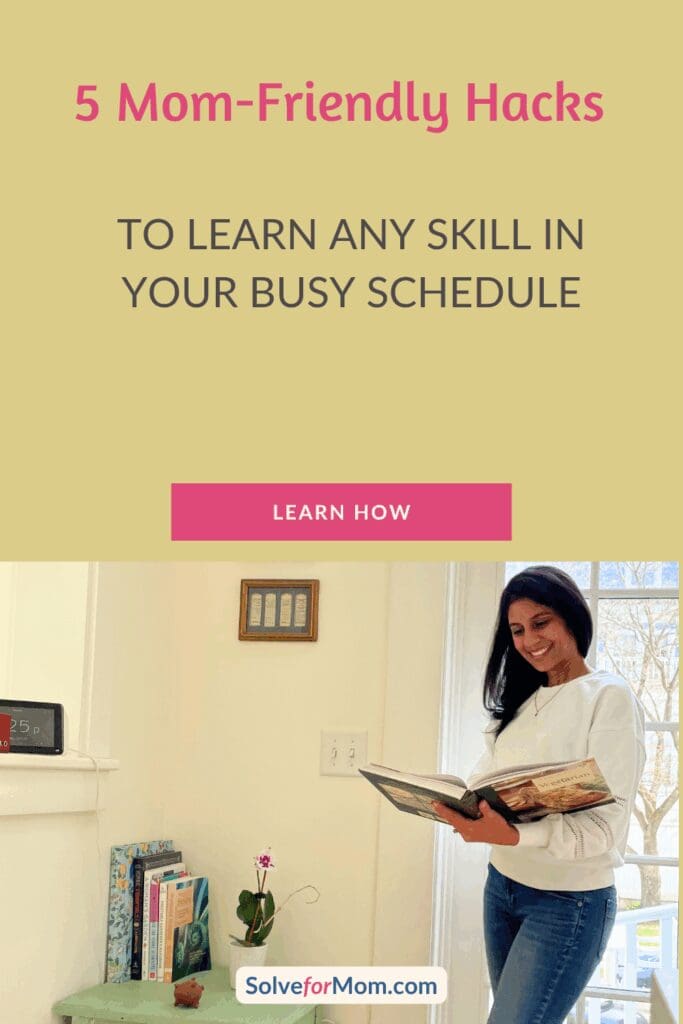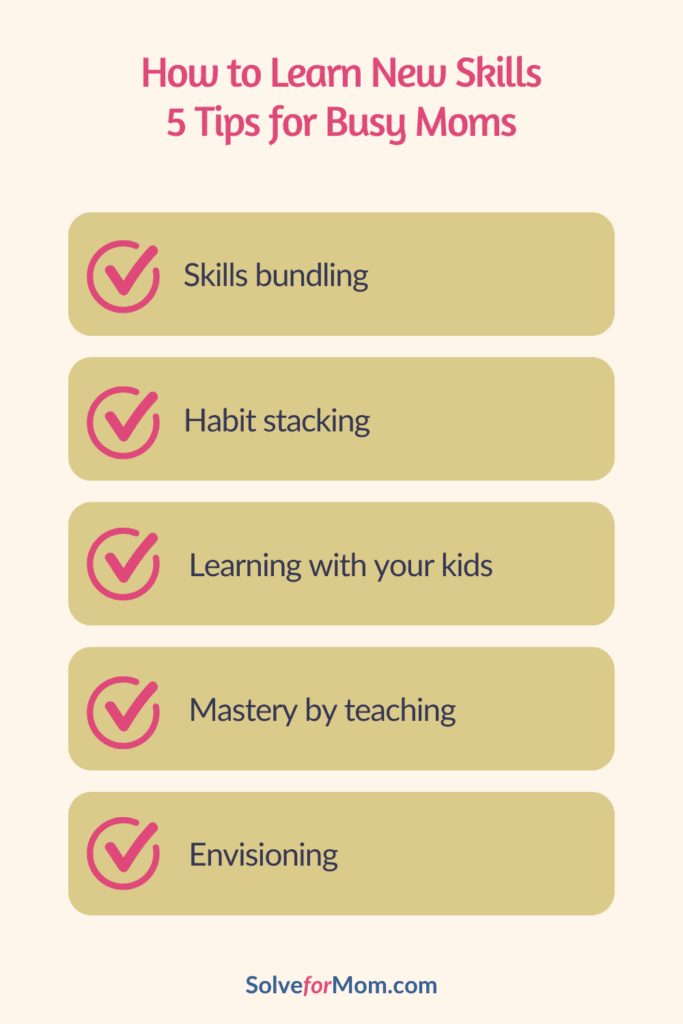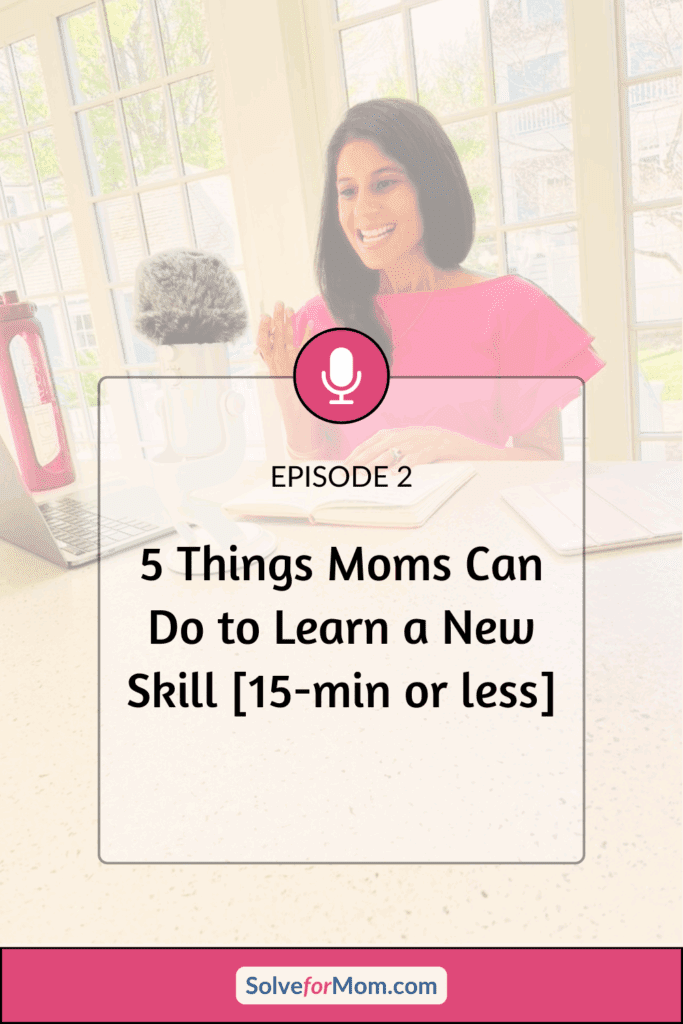- freebies -
It's All Yours
- blog posts -
Must-Read
If it involves goals, planning, and helping you live out your supermom dreams without compromising your time, energy, or family connection, then I'm betting we have a lot to talk about.
Stay Committed to How You Plan To Show Up for Yourself
5 Ways Moms Can Learn a New Skill in 15 Minutes
June 30, 2025
You might wonder: “How can I learn a new skill worth pursuing when time is already so limited?“
As a mom, you balance countless roles and responsibilities. The daily demands are physically taxing, and you’re constantly on the move—all while keeping your family as your top priority.
You’ll discover why building skills matters, especially for busy moms. We’ll explore the fundamentals of how to learn fast within the context of real motherhood, and I’ll show you practical ways to develop new abilities despite your packed schedule.
So let’s jump in!
The Challenge of How to Learn New Skills At Home
You are juggling a lot.
As a mom, you’ve taken on the enormous job of being leaders of your household. You wear multiple hats as home managers, partners, parents. It’s your job to teach, support, guide and nurture the next generation.
But somehow culturally, we’ve normalized the idea that we exchange our freedom and mental well-being when we become mothers.
And I just don’t agree with this.
I believe moms can continue to fill these important societal roles while retaining their own identity, their personal life goals and mental health.
We can do this by nurturing our own skills and interests and passions alongside nurturing our families.

Importance of Moms Developing New Skills
Think of it this way. Why do our kids spend their day in school?
To learn, gain knowledge and skills…Yeah, but why?
Education is important for the opportunity and freedom that knowledge and skills bring them. It’s an investment that families make in terms of time, energy, and oftentimes money, so that they have a future filled with opportunities and freedom to pursue and thrive on what they are passionate about. Well, the same goes for us when we learn new skills and motherhood.
We have to start thinking of learning and skill building as a lifelong process.
Our passion projects require skills. We get introduced to new concepts and then we build skills and then we start honing in and refining those as we practice them. In doing so, not only are we more informed for making decisions, but we are also empowered to do more for ourselves and our families.
So skills and knowledge also afford us as moms opportunities and freedom.

How Do You Learn New Things During Motherhood?
Now that we understand why continuing to learn skills is important, let’s explore the key features of learning.
Skills generally fall into two categories: things we need to do and things we want to do. For example, if my child has a gluten allergy, I have to learn to cook gluten-free meals. In contrast, learning pottery is something I want to do.
Understanding the difference between “need to’s” and “want to’s” helps you prioritize which skills to tackle first.
Learning can happen in several different environments:
- Formal setting – classrooms or mentorships where an instructor checks in periodically but isn’t present for daily learning
- Practical environment – hands-on experience through on-the-job training, internships, or apprenticeships
- Informal set-up – self-directed learning through observing experts and teaching yourself, common with hobbies
- Combination of the formal, practical, and informal arrangements
Throughout my life, I’ve received many types of training. However, since becoming a mom, most of my learning—both the “have to’s” and “want to’s”—has been through a mix of practical, informal, and independent approaches.
Another key feature is how we receive information. While traditional classes present concepts in a linear fashion, real-world learning is quite different.
First, let’s consider the logistics. Instead of set learning times, we grab opportunities when they arise—like during that precious naptime hour. We often practice with others around us, which can feel intimidating. And we frequently learn while juggling family responsibilities, which means some multitasking is inevitable.
The learning process itself isn’t linear either. Gone are the days of neat textbook chapters and organized PowerPoint slides that we can file away perfectly.
5 Tips to Learn a New Skill
Considering all of that, how do you build a new skill at home as a busy mom? Let me share five tips that I use to put skills into action in my busy mom life.
After my youngest son was born, I had to triage everything except motherhood—work, friendships, fitness, hobbies, and sleep (though sleep deprivation comes with the territory). Me-time and passion projects? Those were completely off the table.
I was a total stress ball back then, as anyone who knew me can attest. My eldest had transformed from a textbook angel baby into a challenging toddler. This change left me frustrated and longing for peace and calm so I could enjoy time with my newborn.
That’s when I began exploring how to shift my parenting approach from punitive to gentle, peaceful, and joyful. Without realizing it at first, peaceful parenting became my new passion project. I’ll use this as an example of how I managed to learn new parenting skills everyday during an intensely busy and emotional period.

1. Skills bundling
The first tip is to learn about a new skill while doing other things. I call that skills bundling.
Bundling is actually the concept of combining two tasks sort of into one in a way that’s very complimentary and synergistic.
But I like to apply it when I learn a new skill, and I do it all the time.
So for example, back in those early days, I would read those parenting books while I was waiting, you know, at pediatrician appointments and other waiting rooms. I would listen to parenting podcasts and audiobooks while I pushed my kids in the stroller. I still do that, but now I do it while I clean the house or drive or go for runs.
Even minutes gets you further than where you were before.
And it’s not just for information that you passively consume. Skills bundling works even better for practical skills. I remember this time when I was working on a collage for a personal project. And instead of using the software that I normally would have used, I actually used it as an opportunity to learn and explore Canva, which I had needed to gain some proficiency in anyways.
When you start looking out there, there are so many opportunities for skills bundling.
2. Habit stacking
Create a new habit by attaching it to something that you already do regularly—this is called habit stacking.
This powerful concept was popularized in the book Atomic Habits. Author James Clear explains how you can build a new habit by leveraging an existing one, and he provides fascinating neuroscience behind why habit stacking works.
While I won’t delve into the science here, I’ve actually been using this technique for years, starting from my student days, to build skills. As a Type A personality, this structured approach really resonates with me—and if you’re similarly wired, you’ll love it too.
Let me share a parenting example. I wanted to create stronger connections with my toddler by increasing positive interactions and reducing yelling. Surprisingly, I needed to deliberately practice connecting with my toddler, even though bonding had felt so natural with babies.
I took advantage of my toddler’s established bath and bedtime routine. During bath time, instead of focusing solely on getting clean, I dedicated time for play and silliness. After pajamas, rather than rushing through one or two books, I transformed storytime into quality engagement—having meaningful conversations inspired by what we read.
During our bedtime snuggles, as I tucked him in, I’d quickly reflect: Did today have more positive interactions than negative ones? This simple check-in helped shape my approach for the next day.
I created another habit stack around nursing my baby. After each feeding session—when my baby was most content—I’d bring out a special toy bag for my toddler. Since these toys weren’t always available, this became an exciting, special playtime for us to bond together.
3. Practicing skills with your family
The third tactic is to practice your skills with your kids. This approach naturally brings your children into your interests—they get to see your perspective and experience what you experience. It creates wonderful bonding moments, making it a true win-win.
I often think my kids will only want to participate for five minutes, but they frequently surprise me by staying engaged much longer.
Here’s a personal example: I’m not a professional cook (my husband is actually the family chef), and nearly every time I’m in the kitchen, I’m learning something new. So I invite my kids to join me, saying “Let’s learn this together!” It becomes a two-way learning experience—while I’m improving my cooking skills, I’m also teaching them about measurements, fractions, and even basic chemistry.
This approach truly puts family connection at the forefront.
4. Mastering a new skill by teaching it
The fourth tactic, which builds on the previous one, is teaching your skills to your kids.
This only takes a few minutes, but teaching is one of the most powerful ways to reinforce what you’ve learned.
It also builds your confidence in topics you’re still mastering.
Let me share an example from gentle parenting: Parents need to learn emotional regulation first, since this helps our kids develop the same skill. When I felt triggered, I made a conscious effort to practice regulating my emotions in front of my kids. Even now, years later, this remains challenging. But as I improved, I noticed my children did too. By modeling these skills and teaching through example, we all grew together.
5. Envisioning
Envisioning involves picturing yourself practicing your skill effortlessly and flawlessly—like a mental walkthrough where you imagine mastering the skill perfectly.
While it might sound a bit mystical, many successful people credit visualization as a key factor in their achievements. I first learned this technique during my competitive gymnastics days, when my coaches taught me to mentally rehearse my routines.
Now, I know you’re thinking: “I’m a busy mom, not a gymnast.” But that’s exactly the point! When you can’t make it to your boxing class, you can mentally practice that new combo dozens of times to perfect it for your next session.
I’ve applied this to parenting too. On days when I caught myself barking orders at my kids too much, I’d start the next morning by visualizing myself maintaining a calm, mature demeanor without raising my voice. This mental practice was almost meditative—and I could do it before even getting out of bed!
Here’s another example: As someone who isn’t a confident cook, I get stressed about cooking for others. This pressure increases since I’m surrounded by talented cooks in my family. But when hosting, I’ve learned to be methodical. I create a detailed list of ingredients and steps, then mentally walk through every stage: what to cut first, which pans to use for multiple dishes, what goes in the oven when. I even visualize the finished meal on the table and imagine its aroma.
The beauty of envisioning is its flexibility—you can practice it anywhere, anytime.
A few minutes during your commute, before bed, or while waiting in line is all you need. This simple yet powerful technique helps you build confidence, plan your approach, and anticipate potential challenges before they arise. It builds discipline in your skill and technique. After bundling and habit stacking, this is the tactic I use most frequently.

How to Learn a New Skill Everyday as a High-Achieving Mom
Okay, ladies! To recap, we talked about why learning is important for busy moms, how it brings opportunity and freedom to our lives, and some of the features of learning in the realities of motherhood.
And then I shared five quick and easy to implement tactics to learn a new skill. Those are:
1. Skills bundling: Learn skills while doing other tasks (e.g., listening to podcasts while walking)
2. Habit stacking: Attaching new learning habits to existing routines
3. Learn new skills with kids: Involving children in your learning process for mutual benefit
4. Mastering skills by teaching: Reinforcing your learning by teaching it to your children
5. Envisioning: Mentally practicing and visualizing the skill. This is one of the best ways to learn a skill quickly and for free
I want you to get comfortable with one technique and then try to add in another. And really, have fun with them. Be creative.
The most important part about skills is to take action.
The worst thing you can do is what I did early in my motherhood. I made this false assumption that I just don’t have time. If I couldn’t spend hours working on something I was passionate about, it just wasn’t worth doing at all.
Practicing and doing it imperfectly as it may be with all the chaos around you is way better than just passive learning. You also learn faster when you’re practicing rather than just consuming information.
And remember, it’s a journey. So for example, my parenting style has continued to evolve as I’ve learned from more experts and practiced more skills, and I’ve started to figure out what works and doesn’t work for my family.
Stick with me. I will empower you to do the same with whatever skills you feel pulled to learn a new skill.
Learn a New Skill
PICK ONE TIP TO TRY TODAY
- 🔲 Choose one learning tactic to start with and gradually add more
- 🔲 Focus on progress over perfection – even minutes of practice count
IF YOU LIKED THIS BLOG
- Subscribe to the *Achieve Your Ambitious Mom Life* podcast and share it with other high-achieving mothers
- Ask a question or share your thoughts. Your message could be the topic of an upcoming podcast episode!
EP 3: Working on a Home Project? Get it DONE While Focusing on Family Time [Part 1]
Ep 7: 10 Low Cost Solutions for Investing in Your Personal Growth. Stay-at-home Moms – Listen in!
Leave a Reply